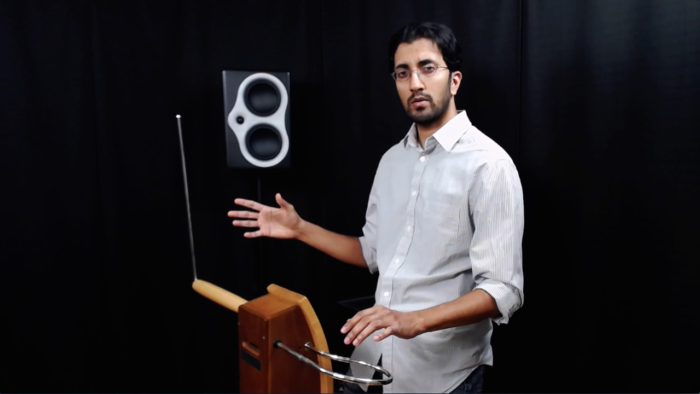If you are interested in Theremin Lessons please read on and also visit the Lessons Page for more of the finer detail. If you are anxious to get started with theremin lessons right away, then jump over to the Contact Page and send me a message. The following summary was previously located on that page, but it’s a bit lengthy so I’ve moved it here for anyone interested in my philosophy on theremin proficiency and education.
Guided Theremin Instruction
Learning to play the theremin can be a very fun and rewarding experience. Everyone begins in the same place, whether they realize it or not. We stumble upon the idea that by moving our hands in the air we can create something musically satisfying. I’ve learned the hard way that the journey toward proficiency on this amazing instrument is full of pit falls. I have literally started from scratch several times, building a new approach each time, in an effort to not repeat things that were inefficient or impractical. Because I was willing to make mistakes, after many years I was able to build a technique that was efficient, precise, and consistent. These are qualities that have always applied to developing proficiency other instruments, but the theremin is unique because quite often people begin playing it without any fundamental understanding of its operating principles. Furthermore, many people fail to realize that a majority of theremin playing involves developing control over their own body.
Technical proficiency on a theremin is something that is not well defined. For decades since its inception, very few people could see the need for it to be used beyond its stereotype of eerie oscillating sound effect. It all depends on the music and the context. Well, it’s the end of 2015 and we have definitely moved beyond old age thinking. An increasing number of people are now demonstrating that the theremin can be used to play not only melodies, but full scale modern compositions with orchestras and bands. The future looks bright thanks to composers that are taking notice of the technical potential that is present in a proficient thereminist.
In my teaching method, I outline key components as the most essential building blocks to make theremin playing easier. My goal is to empower a new generation of theremin players with these fundamental building blocks so that each person can develop a playing facility that suits their musical context. The method is based on problem solving and building a key set of memorized muscle behaviors. Every theory I introduce can be applied toward producing a desired result. I do not introduce concepts that are based on conventions simply because they have been repeated by the majority of theremin players in the world. There have been a number of ideas that have circulated for decades because they had been passed around by musicians that were not fully aware of the mechanics of the interface.
Many people who have played the theremin have given up on advancing beyond a certain point for one reason or another. It’s very easy to just quit and blame the difficulty on the “crazy instrument”. Everything in theremin playing can be built upon fundamental building blocks and an understanding of the playing interface. The plateau that many people find they can not move beyond is quite plainly a result of poor foundation, misunderstanding of basic operating principles, and self-created barriers. To gain proficiency on the theremin it is imperative to know the difference between player error and machine error. This can only happen when a complete foundation has been established. I believe there is enormous potential that can be unlocked in theremin players and the main obstacle to overcome is poorly laid foundation.
Outline of the Methodology
Fundamental blocks:
-
- – How Pitch is affected by Capacitance
-
- – Body Stillness, Posture, and Self Awareness
-
- – Linearity of the physical movement
-
- – Aural/Muscular Feedback System
-
- – Relative Pitch Interval Memory
- – Instrument Tuning, Position, Warm up and Care
Advanced blocks:
-
- – Building repeatable gestures for full range scales and arpeggios
-
- – Minimizing Note transition time for improved pitch precision
-
- – Building a palette of vibrato options
-
- – Articulation with the Volume Hand
-
- – Unlocking Pitch Hand Finger Dexterity
- – External Instrument Modifications

